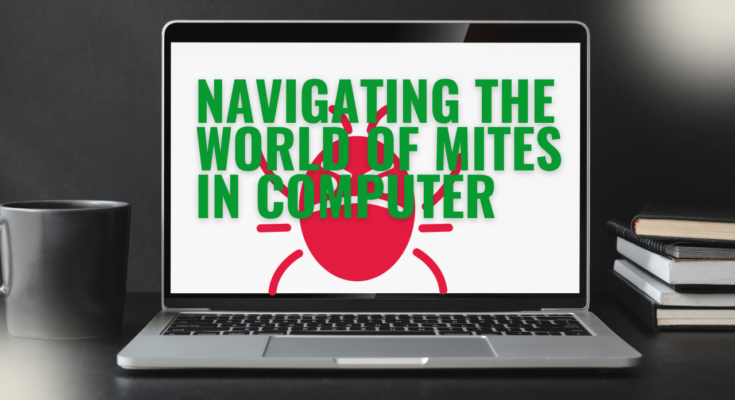Navigating the World of Mites in Computer
Introduction:
Within the wide world of computer systems, Mites in Computer are a silent, covert menace that is frequently disregarded. These virtual mites, which may infect and disturb the delicate ecosystems of our digital devices, are malevolent pieces of code, not insects like their minuscule counterparts in the natural world. We will examine the traits, possible dangers, and precautions against computer mites in this piece as we take a closer look at this fascinating topic.

Understanding Mites in Computer:
In the context of cybersecurity, “Mites in Computer” are tiny, dangerous programmes or bits of code that intentionally compromise computer systems in order to do damage. In addition to viruses, worms, Trojan horses, and other malware, Mites in Computer can also take on other forms. Computer mites are difficult to find until they have already caused damage because, like their namesake in the natural world, they are frequently undetectable.
Why They’re Drawn to Your Device:
The answer lies in their innate drive for survival. Computers, with their constant operation, emit heat, creating an inviting environment for mites seeking warmth. Additionally, the organic materials present in the form of dust particles, skin flakes, and even lingering food crumbs provide a delectable buffet for these microscopic intruders. It is within this amalgamation of warmth and sustenance that computer mites find an opportune habitat to thrive and carry out their disruptive activities.
Potential Risks:
Mites in Computer infestation can be quite dangerous, endangering our electronic gadgets’ dependability and efficiency. These dangers take the form of different malevolent behaviours, each of which poses unique difficulties for our computer systems’ security and privacy:
- Data Theft and Breach: Computer worms are specially designed programmes that take advantage of flaws in a system to provide access without authorization, which opens the door for possible data breaches and theft. The security of private and sensitive data stored on computers—including vital information like login passwords, financial information, and private documents—is seriously threatened by this illicit behaviour.
- Interfering with System Operations: Some computer viruses are made expressly to cause problems for a computer system’s normal operation. This may lead to frequent crashes, a gradual decline in performance, and, in more extreme cases, total system breakdowns. In addition to being inconvenient, these disruptions run the danger of reducing productivity, especially in crucial operational situations.
- Espionage and surveillance: Certain computer mite strains are engineered expressly to serve as espionage tools, allowing unapproved parties to carry out surreptitious monitoring missions. This means secretly monitoring user activity, logging keystrokes, and gaining unauthorised access to private data. The implications extend beyond mere data theft, since the compromised information may be utilised for more espionage-like actions.
- Botnet Formation: Computer mites can be instrumental in forming a larger network known as a botnet. In a botnet, one compromised device controls many compromised devices. The accumulated power is subsequently used for various malicious endeavours, one of which is the widespread use of distributed denial-of-service (DDoS) attacks. These botnets are able to overwhelm particular systems, rendering them unusable and causing disruptions to internet services.
Different Kinds Of Computer Mites
There is no specific species mentioned when we talk about “computer mites.” A computer mite is any microscopic bug that resides in or on your computer!

The most frequently used gadget on your smartphone may have many pests. Among the less typical are:
- Bed bugs
- Spider mites
- Aphids
- Ants
- Booklice
- Baby cockroaches
- Thunderbugs
Those are all common pests you encounter within your home. Any of them can gravitate towards your computer and set up shop.
Safeguarding Against Mites in Computer:
Adopting a comprehensive and multifaceted cybersecurity approach is essential to bolstering the security of our computer systems against the stealthy menace of mites. Here are key strategies to safeguard against Mites in Computer:
Area |
Prevention |
| Environment | * Maintain low humidity with a dehumidifier. * Avoid using your computer in damp areas. * Ensure good airflow around the computer. |
| Food Sources | * Do not eat or drink near your computer. * Clean up spills and crumbs immediately. |
| Cleaning | * Regularly wipe down the computer, keyboard, and mouse with a slightly damp cloth. * Pay close attention to crevices, vents, and ports. * Vacuum accessible areas with a soft brush attachment. |
| Hardware | * Do not use compressed air inside the computer case. * Use compressed air (safe distance, computer off & unplugged) on vents and ports. |
1. Protecting Against Mites:
Using dependable antivirus software is an essential line of defence in the ongoing combat against Mites in Computer. This programme acts as a vigilant guard, actively locating and eliminating mites from the system. Regular updates and planned scans reinforce this defense’s efficacy and ensure that it remains resilient to attacks that are always changing.
2. Fortifying with Firewalls:
Building robust firewalls and putting in place extensive network security measures is an essential preventative precaution against unwanted access and possible computer malware penetration. Firewalls function as virtual barriers that carefully inspect all incoming and outgoing communication in order to prevent harmful activity. By adding another line of defence, the security posture is strengthened and those trying to compromise the system face significant challenges.
3. Regular System Updates:
One proactive way to protect against prospective mite assaults is to make sure that every aspect of the computer system is updated on a regular basis. This entails providing operating system, application, and specialised security software updates on schedule. It is much harder for mites to take advantage of system vulnerabilities because these upgrades are routine and serve as a preventive step against known vulnerabilities.
4. User Empowerment through Awareness:
Teaching users about safe online conduct is a crucial defence against mite infections. It is imperative to apprise clients of the possible risks linked to dubious downloads and stress the significance of exercising caution while accessing unsolicited email attachments. Through proactive promotion of a cybersecurity awareness culture, individuals can significantly contribute to the preservation and fortification of the system’s overall resilience.
5. Keeping Secure Passwords:
As a basic precaution against computer hackers getting unauthorised access, it is imperative to highlight strong password practices. Supporting multi-factor authentication and encouraging users to generate unique, complicated passwords enhances the security of critical data and system resources.

6. Behavioral Analysis Tools:
Incorporating advanced behavioral analysis tools can enhance the system’s ability to detect anomalies indicative of mite activity. These tools analyze patterns of behavior within the system, allowing for the early identification of potentially harmful activities and swift mitigation.
7. Backup and Recovery Planning:
Implementing regular data backups and establishing a comprehensive recovery plan are essential components of mite defense. In the event of a mite-induced system compromise, having up-to-date backups ensures the availability of critical data, minimizing the impact of an attack.
8. Incident Response Readiness:
Developing a robust incident response plan equips organizations to swiftly and effectively respond to potential mite infiltrations. This includes clear procedures for isolating affected systems, analyzing the extent of the breach, and implementing remediation measures to restore normalcy.
Through the integration of these all-encompassing tactics into a cohesive cybersecurity architecture, individuals and organisations can significantly enhance their resilience against the persistent and constantly evolving danger posed by mites in computer. Proactively putting these precautions into practice not only fortifies the digital environment but also ensures that computer systems remain secure and intact even in the face of ever-changing cyber threats.
Conclusion:
Mites in Computer are a persistent and major threat to the security and functionality of our gadgets within the complex network of computer systems. Like their microscopic namesakes in the natural world, these virtual pests creep into our digital landscapes and pose threats that require a careful and proactive response. The understanding of potential risks associated with computer mites becomes paramount in fortifying our defense mechanisms.

